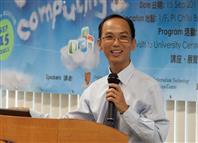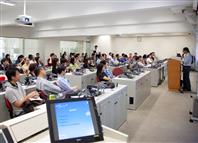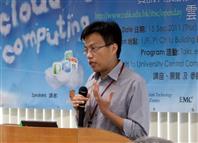‘Cloud computing is a model that delivers IT infrastructure as simply as electricity from the socket. You don’t have to bother with the principle of electricity generation or the maintenance process. You pay only for what you use,’ Mr. So Pak-cheung Roger, head of the Cloud Computing Division of Information Technology Services Office (ITSC), drew an analogy between electricity and cloud computing.
Cloud computing is the buzzword of the moment in the technology field as internet connectivity becomes increasingly speedy and stable. Terms like ‘cloud storage’ are common in advertisements of household network services, showing that the new technology has already penetrated daily life. A study by Cisco System Incorporation, a world-leading networking supplier, which involved a survey of more than 2,000 IT professionals in 13 countries, found that 52 per cent are using—or plan to use—cloud computing services in the near future. The percentages are even higher in the emerging markets of Brazil, India, and China.
Talking about the advantage of cloud computing over traditional computing, Roger said, ‘In the traditional computing system, all computer applications and data files are stored in the hard disk of individual computers or servers. When new software, hardware, and extra space are needed, an office has to acquire and install them as well as to administer the applications. This is somewhat like having each office buy and manage an electric generator on its own.’ If the difference between the estimated and actual usage is huge, there will be wastage. If different offices develop similar programs simultaneously, there’s an overlap of effort.
He continued, ‘Cloud computing is a brand new concept in the computing operation model. It proposes to keep all data files, applications and storage somewhere outside the computer in the internet space named “cloud”. Users can use them on-demand and with much flexibility.’ According to the new model, offices will no longer need to invest in technical maintenance staff and can share new IT services at lower prices.
The Cloud Computing Division of the ITSC was established two years ago, providing solutions to assist departments in automating and enhancing their administrative and office work. Three levels of services are offered: Cloud Software Service (SaaS) such as the Electronic Document Management System and the Online Event Registration System; the Cloud Platform Service (PaaS), available from early 2010, including the building and hosting of websites and applications; the Cloud Infrastructure Service (IaaS), begun a year ago, including virtual machine server hosting and server management support. University offices can contact the ITSC directly to discuss the support they need.
If an office is planning to set up a website, it can seek different levels of help from the ITSC. Roger said user offices can build their own websites and host them on the ITSC server. On the other hand, they can also choose to adopt a user-friendly interface offered by the ITSC and only prepare website contents such as text and images, and filling it up. It takes away the need for individual offices to keep a web server and minimizes that for technical maintenance.
Despite the advantages of the emerging technology, security is one of users’ greater concerns. Certain government departments and organizations, which have to handle much confidential and sensitive information, still hesitate to switch to cloud computing because it seems more reliable to store data inside their own computers. Dr. Lee Pak-ching Patrick, assistant professor, Department of Computer Science and Engineering, admitted that it is a challenging issue to ensure all the information scattered in different clouds won’t leak.
One of his current studies is to develop a new system that deletes backup copies made by cloud when the user removes data from one cloud. Apart from research, the University also places equal importance on teaching of this new technology. In the second semester of 2011–12, a new course ‘Introduction to Cloud Computing’ will be offered to senior undergraduates majoring or minoring in computer science and engineering. ‘A cloud platform will be set up for students to receive hands-on training,’ Dr. Lee remarked. 




































































































































































Social Bookmarks